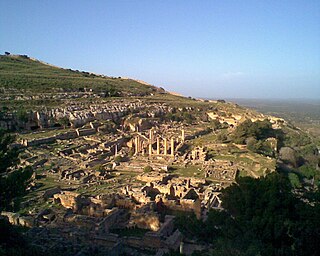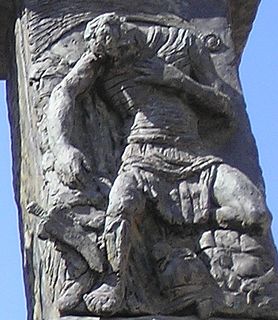Related Research Articles
The 110s decade ran from January 1, 110, to December 31, 119.

AD 66 (LXVI) was a common year starting on Wednesday of the Julian calendar. At the time, it was known as the Year of the Consulship of Telesinus and Paullinus. The denomination AD 66 for this year has been used since the early medieval period, when the Anno Domini calendar era became the prevalent method in Europe for naming years.
Year 115 (CXV) was a common year starting on Monday of the Julian calendar. In the Roman Empire, it was known as the Year of the Consulship of Messalla and Vergilianus. The denomination 115 for this year has been used since the early medieval period, when the Anno Domini calendar era became the prevalent method in Europe for naming years.
Year 116 (CXVI) was a leap year starting on Tuesday of the Julian calendar. At the time, it was known as the Year of the Consulship of Lamia and Vetus. The denomination 116 for this year has been used since the early medieval period, when the Anno Domini calendar era became the prevalent method in Europe for naming years.
This article concerns the period 169 BC – 160 BC.

Cyrene or Kyrene, was an ancient Greek and later Roman city near present-day Shahhat, Libya. It was the oldest and most important of the five Greek cities, known as the pentapoleis, in the region. It gave eastern Libya the classical name Cyrenaica that it has retained to modern times. Located nearby is the ancient Necropolis of Cyrene. The traditional founder of the city was Battus the Lacedemonian, though the exact relationship between the fledgling city and other cities has led historians to question that narrative. Particularly, the idea that Thera was the sole "mother city" is disputed; and the relationship with other cities, such as Sparta and Samnium merchants, is unclear.

Legio III Cyrenaica, was a legion of the Imperial Roman army. The legion had its origins among the forces of Mark Antony during the civil wars of late first century BC. In the Imperial period it was stationed in Egypt, where it played a key role in campaigns against the Nubians and Jews. In the first century AD, it was usually located in Arabia Petraea. There are still records of the legion in Syria at the beginning of the 5th century. The legion symbol is unknown.

The First Jewish–Roman War, sometimes called the Great Jewish Revolt, or The Jewish War, was the first of three major rebellions by the Jews against the Roman Empire, fought in Roman-controlled Judea, resulting in the destruction of Jewish towns, the displacement of its people and the appropriation of land for Roman military use, as well as the destruction of the Jewish Temple and polity.
Syria Palaestina was a Roman province in the Palestine region between the early 2nd and late 4th centuries CE. It succeeded the earlier province of Judaea, which around the time of the Bar Kokhba revolt in 132-136 CE was merged with Galilee into an enlarged Syria Palaestina province. Its capital was Caesarea Maritima.

The Bar Kokhba revolt, or the 'Jewish Expedition' as the Romans named it, was a rebellion by the Jews of the Roman province of Judea, led by Simon bar Kokhba, against the Roman Empire. Fought c. 132–136 CE, it was the last of three major Jewish–Roman wars, so it is also known as the Third Jewish–Roman War or, the Third Jewish Revolt. Some historians also refer to it as the Second Revolt of Judea, not counting the Kitos War, which had only marginally been fought in Judea.

The Jewish–Roman wars were a series of large-scale revolts by the Jews of the Eastern Mediterranean against the Roman Empire between 66 and 135 CE. The First Jewish–Roman War and the Bar Kokhba revolt were nationalist rebellions, striving to restore an independent Judean state, while the Kitos War was more of an ethno-religious conflict, mostly fought outside Judea Province. Hence, some sources use the term Jewish-Roman Wars to refer only to the First Jewish–Roman War and the Bar Kokhba revolt (132–135 CE), while others include the Kitos War as one of the Jewish–Roman wars.

Judaea was a Roman province which incorporated the regions of Judea, Samaria, and Idumea from 6 CE, extending over parts of the former regions of the Hasmonean and Herodian kingdoms of Judea. The name "Judaea", like Judea, was derived from the Iron Age Kingdom of Judah, but the Roman province encompassed a much larger territory.

The Kitos War was one of the major Jewish–Roman wars (66–136). The rebellions erupted in 115, when most of the Roman armies were fighting Trajan's Parthian War on the eastern border of the Roman Empire. Major uprisings by Jews in Cyrenaica, Cyprus and Egypt spiralled out of control, resulting in a widespread slaughter of the remaining Roman garrisons and Roman citizens by Jewish rebels.

Lusius Quietus was a Roman Berber general and 11th legate of Judaea in 117–120. He was the principal commander against the Jewish rebellion known as the Kitos War. As both a general and a highly acclaimed commander, he was notably one of the most accomplished Berber statesmen in ancient Roman history. After the death of the emperor Trajan, Quietus was murdered or executed, possibly on the orders of Trajan's successor Hadrian.

The Second Temple period in Jewish history lasted approximately 600 years, during which the Second Temple existed. It started with the return to Zion and the construction of the Second Temple, while it ended with the First Jewish–Roman War and the Roman destruction of Jerusalem and the Temple in 70 CE.

Judea or Judaea is an ancient, historic, Biblical Hebrew, contemporaneous Latin, and the modern-day name of the mountainous southern part of the region of Israel and part of the West Bank.

The history of the Jews in the Roman Empire traces the interaction of Jews and Romans during the period of the Roman Empire. A Jewish diaspora had migrated to Rome and to the territories of Roman Europe from the land of Israel, Anatolia, Babylon and Alexandria in response to economic hardship and incessant warfare over the land of Israel between the Ptolemaic and Seleucid empires from the 4th to the 1st centuries BCE. In Rome, Jewish communities thrived economically. Jews became a significant part of the Roman Empire's population in the first century CE, with some estimates as high as 7 million people; however, this estimation has been questioned.
Extensive riots erupted in Alexandria, Roman Egypt, in 66 CE, in parallel with the outbreak of the First Jewish–Roman War in neighbouring Roman Judea.
The Galilee campaign, also known as the Northern Revolt, took place in the year 67, when Roman general Vespasian invaded Galilee under the orders of Emperor Nero in order to crush the Great Revolt of Judea. Many Galilean towns gave up without a fight, although others had to be taken by force. Of these, Josephus provides detailed accounts of the sieges of Gamla and Yodfat. By the year 68, Jewish resistance in the north had been crushed, and Vespasian made Caesarea Maritima his headquarters and methodically proceeded to cleanse the coastline of the country, avoiding direct confrontation with the rebels at Jerusalem.
References
- Eusebius, History of the church 4.2.1-5